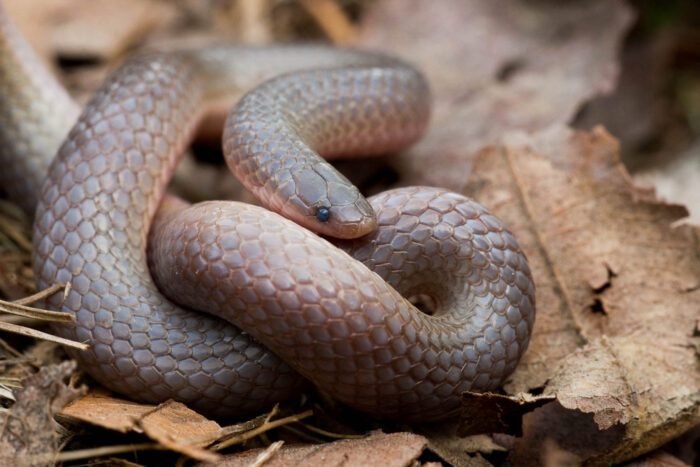Eastern Worm Snake
Carphophis amoenus
The eastern worm snake is a blind, non-venomous snake found all throughout the Chesapeake Bay watershed. It is often mistaken for an earthworm due to its pale-brown color and small size.
This section shows one large critter image at a time. Use the thumbnails that follow to select a specific image to display here.

This gallery contains a grid of small thumbnails. Selecting a thumbnail will change the main image in the preceding section.
Appearance
The eastern worm snake has a pale-brown, smooth-scaled body and light pink belly. Juveniles display the same colors but in darker shades. The eastern worm snake’s head is not distinguishable from the body, and it has a slightly tapered but blunt shape. The tail is small and tapers to a pointed end to help it dig in the soil.
Feeding
The eastern worm snake feeds primarily on earthworms found burrowing beneath leaf litter and logs. When unavailable, these snakes will also eat slugs, spiders, snails and caterpillars by tracking their scent and swallowing them whole. Due to their small mouths, their diet is limited to elongated species.
Predators
These small snakes fall prey to birds, large snakes and lizards, and small mammals such as opossums, foxes, toads, cats and skunks. To protect themselves from threats, eastern worm snakes may flee, burrow under leaf litter and soil or camouflage into their surroundings.
Reproduction and life cycle
The eastern worm snakes begin mating season in late spring from April to June. Come mid-July, females will scope out depressions under rocks and rotting logs to safely lay two to eight eggs. Until the eggs hatch in late August, females will spend 75% of their time guarding them from predators. Hatchlings will take 3 years to sexually mature and begin their own breeding cycles. Eastern worm snakes are known to live about 4 to 5 years.
Did you know?
Eastern worm snakes are also referred to as blind snakes, thunder snakes, milk snakes, eastern twig snakes and cricket snakes.
These snakes' eyes get smaller during fetus development and ultimately hatch with zero visibility.
Eastern worm snakes are often mistaken for earthworms due to their small size and pale-brown color.
If handled, they emit a bad-smelling musk.
To avoid drying out, these snakes will remain hidden beneath moist soil throughout most of the summer months.
The eastern worm snake is one of two subspecies of worm snake; the other being the western worm snake (Carphophis vermis), found west of the Mississippi River.
